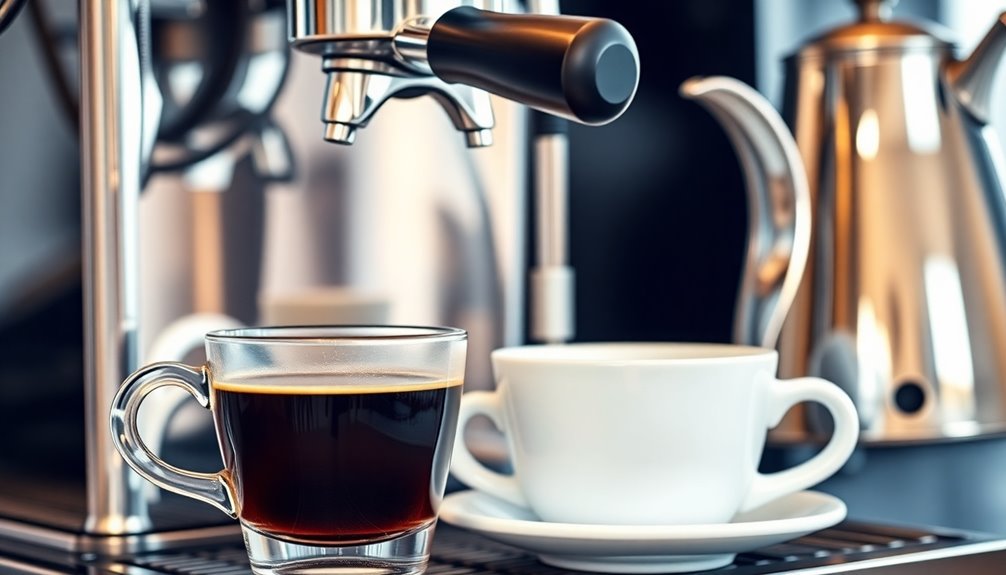To quickly fix espresso channeling, start by adjusting your grind size to achieve consistency—finer to prevent water skipping or coarser to avoid quick flows. Use a light, steady tamp to prevent over-compression, and distribute your coffee evenly before tamping. Pre-wet your grounds to improve bed uniformity, tap and level the portafilter, and regularly clean your equipment. Experiment with different filter types and sizes to optimize flow, and keep refining these small tweaks for better shots each time.
Key Takeaways
- Ensure even coffee bed preparation by leveling grounds and distributing evenly before tamping.
- Use a gentle, consistent tamp pressure to prevent over-compression and promote uniform water flow.
- Pre-wet coffee grounds lightly to reduce clumping and improve bed uniformity during extraction.
- Regularly clean and maintain equipment to prevent residue buildup and blockages that cause channeling.
- Adjust grind size incrementally and experiment with filter types to optimize flow and minimize channeling.
Adjust Your Grind Size for Consistency

To prevent channeling and guarantee a more even extraction, adjusting your grind size is vital. When your grind is too fine, water struggles to pass through, causing over-extraction and uneven brewing. Conversely, a grind that’s too coarse allows water to flow too quickly, resulting in under-extraction. Achieving grind consistency ensures each shot is uniform, reducing the chance of channeling. Always start with fresh beans, as their oils and moisture levels influence grind behavior. Grind size directly impacts extraction quality, so tweak it in small increments, testing after each adjustment. Consistent grinding techniques help maintain uniform particle size, which is essential for a balanced, flavorful espresso. Proper tamping pressure also plays a critical role in preventing channeling and ensuring even extraction. By paying attention to grind size and using fresh beans, you’ll notice a significant improvement in your espresso’s quality and consistency.
Use a Light Tamp to Prevent Over-Compression

Using a light tamp helps you apply consistent pressure, reducing the risk of over-compression. When your tamp pressure is even and gentle, your extraction improves and channeling decreases. Practice a steady, light touch to boost your espresso’s overall quality. Additionally, maintaining the right drivetrain components ensures smooth gear shifts and consistent performance during your brewing process.
Consistent Tamp Pressure
Applying consistent tamp pressure is essential for achieving ideal espresso extraction, and often, a lighter tamp can prevent over-compression. When you focus on tamp pressure, you improve consistency control, which leads to more predictable results. A steady, gentle tamp ensures the coffee bed isn’t overly compressed, reducing channeling risks. To maintain consistency:
- Use the same amount of force each time
- Keep your tamp hand steady
- Apply even pressure across the puck
- Practice with a tamper gauge for precision
- Focus on smooth, controlled motions
- Contrast ratio plays a role in how well the extraction reveals detailed flavors, so maintaining even tamping helps optimize image quality during brewing.
Enhances Extraction Quality
A lighter tamp can markedly improve your espresso’s extraction quality by preventing over-compression of the coffee puck. When you use less tamp pressure, you’re allowing water to flow more evenly through the coffee, reducing channeling and under-extraction. Adjusting your grind size becomes vital—finer grinds increase resistance, so a gentle tamp balances this, ensuring ideal extraction. If your tamp is too heavy, the water struggles to pass through, resulting in a bitter, over-extracted shot. Conversely, a light tamp maintains proper flow and highlights the coffee’s nuanced flavors. Focus on applying just enough tamp pressure to evenly compress the coffee without excessive force. This small change enhances extraction quality by promoting consistent, balanced extraction and better showcasing your espresso’s full flavor potential. Additionally, understanding the importance of a dedicated space for your brewing process can help maintain consistency and focus during each shot.
Distribute Coffee Evenly Before Tamping

Have you ever noticed uneven espresso shots even when your grind size and tamp pressure seem correct? The key might be how you distribute the coffee grounds before tamping. Proper grind distribution ensures an even bed, reducing channeling and improving extraction. Before pressing, gently shake or tap the portafilter to settle the coffee, then use a distribution tool or your finger to level the surface. This step helps avoid air pockets and uneven density. When you apply your tamping technique, a consistent foundation is vital. Focus on spreading the grounds evenly across the puck, which promotes uniform water flow. Small adjustments here can substantially boost shot quality and consistency. Ensuring your technique includes proper distribution methods can make a significant difference in your espresso results.
Pre-Wet Your Coffee Grounds to Improve Bed Uniformity

Pre-wetting your coffee grounds can considerably enhance bed uniformity, leading to more consistent extraction. When you pre wet grounds, you help them absorb moisture evenly, which reduces clumping and promotes a stable coffee bed. This step ensures the grounds settle uniformly and minimizes channeling during extraction. To pre wet grounds effectively, lightly spray or pour a small amount of water over the coffee before tamping, just enough to dampen the surface without pooling. This process allows the grounds to expand slightly and settle into a more uniform bed. Incorporating coffee bed uniformity into your routine is a simple, quick fix that can significantly boost your espresso quality. Improved coffee bed uniformity results in better extraction, richer flavors, and fewer uneven shots.
Tap and Level the Portafilter for a Smooth Surface

After pre-wetting your coffee grounds, the next step is to guarantee the surface is perfectly even before tamping. Tap the portafilter handle gently on the counter to settle the grounds and remove air pockets. Use a leveling tool or your finger to distribute the coffee evenly across the surface, ensuring no high spots remain. This improves the tamping technique by creating a consistent pressure and reducing channeling. A smooth, level surface helps water flow evenly through the coffee bed, enhancing extraction quality. Remember, a well-tapped and leveled bed minimizes uneven extraction and bitterness. Incorporate these tips for better espresso shots.
Pre-wet grounds, tap gently, level evenly for smooth, consistent espresso extraction.
- Gently tap the portafilter handle after dosing
- Use your finger or a leveling tool to even out grounds
- Check for high spots or uneven areas
- Apply consistent tamping pressure
- Ensure the surface is flat before tamping
Check Your Dose to Ensure Proper Coffee Quantity

Ensuring you use the right amount of coffee is essential for a balanced extraction. Accurate coffee measurement guarantees consistent dosing accuracy, which directly impacts flavor and channeling. To verify your dose, use a reliable scale and measure your coffee each time. Small deviations can cause uneven extraction, so precision matters. Additionally, paying attention to voiceover script optimization can improve your delivery and overall presentation. Here’s a quick reference:
| Coffee Dose (grams) | Resulting Shot Quality |
|---|---|
| 18-20 | Optimal balance, minimal channeling |
| 16-17 | Under-extraction risk, weak flavor |
| 21-22 | Over-extraction, bitter taste |
| Less than 16 | Weak espresso, poor crema |
| More than 22 | Overly bitter, clogging |
Consistently checking your coffee measurement guarantees proper coffee quantity, enhancing shot quality and reducing channeling issues.
Clean Your Equipment Regularly to Avoid Residue Build-Up

Regularly cleaning your equipment prevents blockages that can disrupt your espresso shot. It also preserves the rich flavor you want and helps your machine last longer. Staying on top of maintenance keeps your setup running smoothly and efficiently. Additionally, implementing robust safety measures can help prevent equipment failures and ensure consistent performance.
Prevent Espresso Blockages
To prevent espresso blockages, keeping your equipment clean is essential. Residue build-up can clog your machine, disrupting grind uniformity and tamp consistency. Regular cleaning ensures water flows smoothly through the portafilter and prevents old coffee oils from causing channeling. Additionally, maintaining proper hygiene helps preserve the longevity and performance of your espresso machine. Special Occasions
Maintain Optimal Flavor
If you want your espresso to taste its best, keeping your equipment clean is essential. Residue buildup can affect grind consistency, leading to uneven extraction and dull flavors. Regularly cleaning your espresso machine and grinder guarantees that old coffee oils and particles don’t interfere with the fresh grind. Proper maintenance helps you maintain consistent tamp pressure, preventing over- or under-extraction. When your equipment is clean, you can focus on dialing in your grind size and tamp pressure without worrying about residue skewing your results. This consistency in grind and tamp leads to a richer, more balanced flavor profile. Make cleaning part of your routine, and you’ll notice your espresso tasting fresher and more vibrant with every shot. Sound healing science research indicates that maintaining equipment can also promote a more relaxed brewing process, enhancing overall enjoyment.
Extend Equipment Lifespan
Keeping your equipment clean not only guarantees better-tasting espresso but also markedly extends its lifespan. Residue build-up can cause blockages, impairing equipment calibration and making your machine work harder. This can lead to unnecessary wear and tear, reducing overall durability. Regular cleaning enhances barista ergonomics by preventing clog-related strain and streamlining workflow. To maximize longevity, focus on these key practices:
- Clean brew group and portafilter daily
- Descale to prevent mineral buildup
- Wipe steam wand after each use
- Check and calibrate equipment regularly
- Use proper cleaning agents suited for your machine
- Pay attention to air quality around your workspace, as dust and pollutants can settle on equipment and impair performance.
Incorporating these habits ensures your equipment stays in top shape, reduces maintenance costs, and supports consistent espresso quality. Proper cleaning is an essential step toward extending your machine’s lifespan and maintaining excellent performance.
Experiment With Different Filter Types and Sizes

Choosing the right filter type and size can considerably influence your espresso channeling results. Different filters affect water flow and coffee bed compression, impacting extraction quality. Experiment with filter experimentation by trying various shapes and materials, such as basket filters or bottomless filters. Size variation also matters; a smaller filter may increase pressure, while a larger one offers more even flow. Here’s a quick comparison:
| Filter Type | Size Options | Effect on Channeling |
|---|---|---|
| Basket Filter | Small, Standard | Potential for uneven flow |
| Bottomless Filter | Medium, Large | Better visibility, flow |
| Flat Bottom Filter | Various sizes | Consistent extraction |
| Conical Filter | Custom sizes | Improved water distribution |
Adjusting filter types and sizes helps you find the *best* setup for consistent channeling. Additionally, understanding how filter design influences water flow can further optimize your brewing process.
Frequently Asked Questions
How Does Grind Size Affect Channeling in Espresso?
Your grind size directly impacts channeling by influencing water flow during extraction. If it’s too fine, tamp pressure increases and can cause uneven distribution, promoting channeling. Conversely, a coarser grind may lead to uneven water flow, also causing channeling. Using distribution tools helps make certain of uniform tamping, while controlling humidity affects grind consistency. Adjusting grind size carefully helps minimize channeling, leading to a more balanced and flavorful espresso shot.
What Is the Ideal Tamp Pressure for Preventing Channeling?
You should aim for around 30 pounds of tamp pressure to prevent channeling, like gently pressing a spring to release its full potential. Use consistent tamping techniques to guarantee even pressure across the coffee bed. Fresh coffee beans demand careful handling; if they’re too old, even perfect tamping may falter. Keep your tamp firm yet controlled, and your espresso will flow smoothly, highlighting the bright flavors of your freshly ground beans.
Can Different Coffee Bean Roasts Influence Channeling Issues?
Yes, different coffee bean roasts can influence channeling issues. Light roasts often have more complex flavors and denser beans, which may require adjustments in grind size and tamping to prevent channeling. Dark roasts tend to be oilier and easier to extract, reducing the risk. Also, the coffee bean origin impacts density and moisture content, affecting extraction. Adjusting your grind and tamp based on roast level and origin helps minimize channeling.
How Does Ambient Humidity Impact Espresso Channeling?
Humidity effects can make or break your espresso shot, so don’t underestimate moisture impact. When humidity rises, it’s like your coffee beans get a moisture makeover, causing uneven extraction and channeling issues. Too much humidity can clog your grinder and mess with grind consistency, increasing channeling chances. Conversely, low humidity leads to dryness, making beans brittle and harder to extract evenly. Keep an eye on ambient humidity to maintain perfect espresso channeling!
Are There Specific Tools to Identify Uneven Coffee Distribution?
You can use tools like distribution tools or tamp mats to identify uneven coffee distribution. These tools improve your distribution techniques by helping you spread coffee evenly before tamping, which reduces channeling. Their effectiveness lies in providing visual or tactile cues, so you can quickly spot uneven areas. Regularly using these tools guarantees consistent coffee grounds, ultimately leading to better extraction and more balanced espresso shots.
Conclusion
Think of your espresso journey as tending a delicate garden. With each small adjustment—like fine-tuning your grind or gently tamping—you nurture a flawless bloom of rich flavor. Regular care and attention keep your equipment healthy, ensuring your shots flourish with vibrant consistency. Remember, even the tiniest change can turn a simple seed into a lush, aromatic masterpiece. Embrace these quick wins as your tools to cultivate perfection, one espresso at a time.










